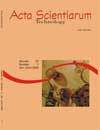The GPS and the constant velocity of light
DOI:
https://doi.org/10.4025/actascitechnol.v22i0.3062Keywords:
relatividade especial, transformações de Lorentz, velocidade da luz, sincronização de relógios, GPSAbstract
The Lorentz transformations and special relativity are unable to provide a realistic physical explanation of the behavior of matter and light. We will show that all these phenomena can be explained using Newton's physics and mass-energy conservation, without space contraction or time dilation. We have seen previously that the principle of mass-energy conservation requires that clocks run at a slower rate in a moving frame, and physical bodies become longer because of the increase of the Bohr radius. These results allow us to answer the question: With respect to what does light travel? For example, when we move away at velocity v from a source emitting light at velocity c, the relative motion of the radiation is observed from the Doppler shift. How can we explain logically that these photons appear to reach us at velocity c and not (c-v)? The conventional explanation relies on special relativity, but it implies an esoteric space-time distortion, which is not compatible with logic. This paper gives a physical explanation how the velocity of light is really (c-v) with respect to the observer, even if the observer's tools always measure a velocity represented by the number c. We explain how this problem is crucial in the Global Positioning System (GPS) and in clock synchronization. The Lorentz' transformations become quite useless. This apparent constant velocity of light with respect to a moving frame is the most fascinating illusion in science.Downloads
Download data is not yet available.
Downloads
Published
2008-05-13
How to Cite
Marmet, P. (2008). The GPS and the constant velocity of light. Acta Scientiarum. Technology, 22, 1269–1279. https://doi.org/10.4025/actascitechnol.v22i0.3062
Issue
Section
Physics
License
DECLARATION OF ORIGINALITY AND COPYRIGHTS
I Declare that current article is original and has not been submitted for publication, in part or in whole, to any other national or international journal.
The copyrights belong exclusively to the authors. Published content is licensed under Creative Commons Attribution 4.0 (CC BY 4.0) guidelines, which allows sharing (copy and distribution of the material in any medium or format) and adaptation (remix, transform, and build upon the material) for any purpose, even commercially, under the terms of attribution.
Read this link for further information on how to use CC BY 4.0 properly.











8.png)




